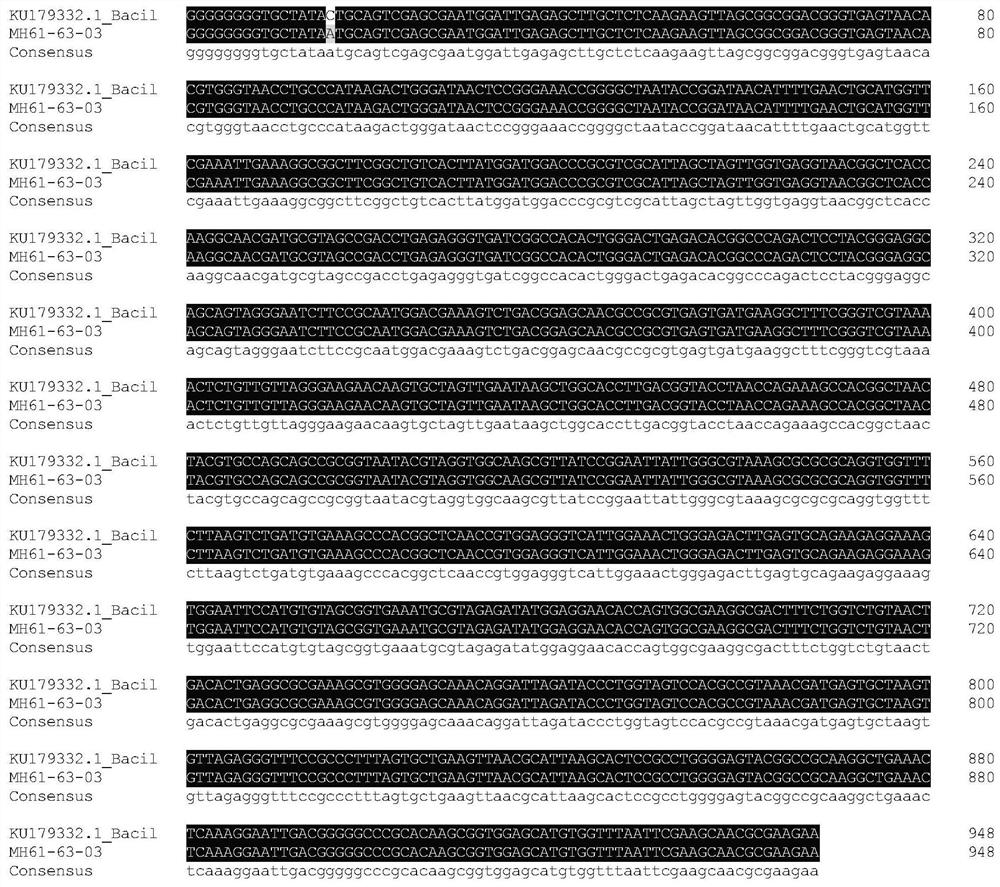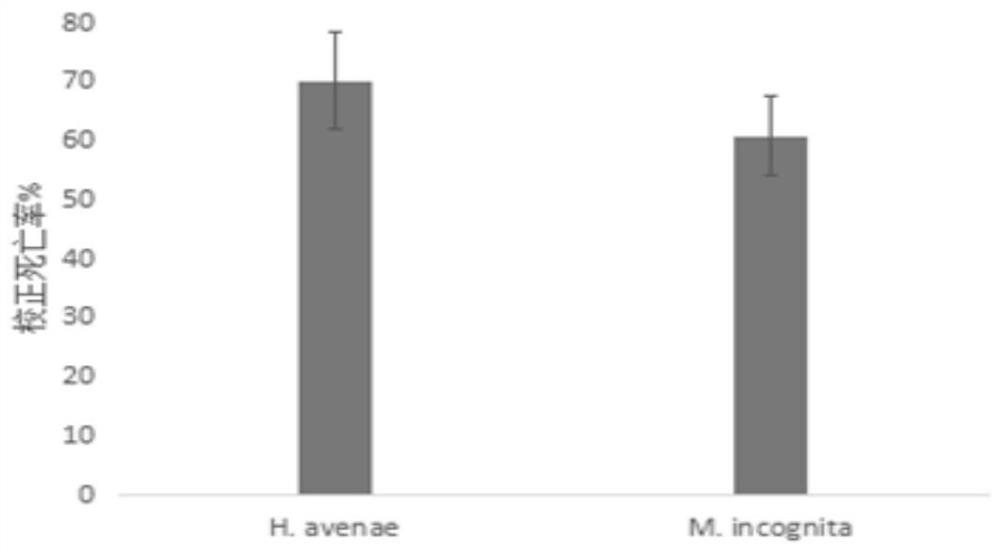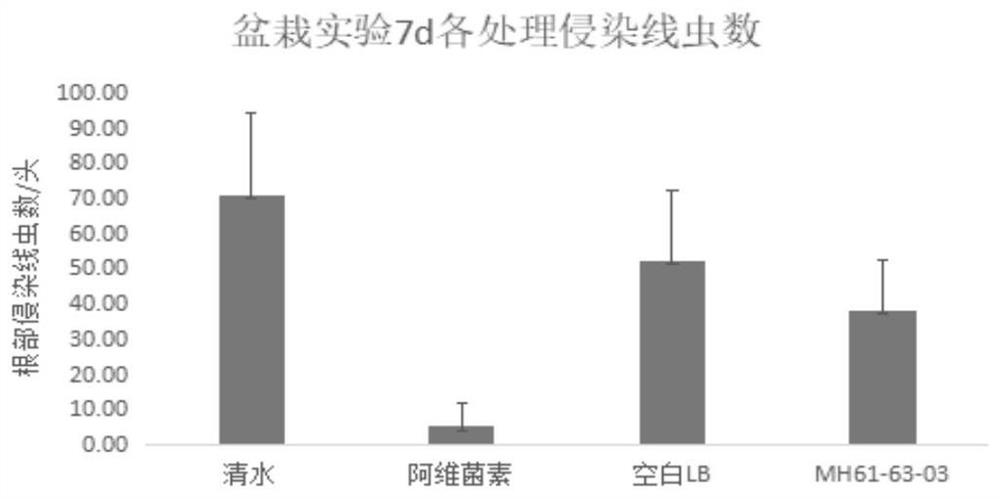A strain of Bacillus cereus for controlling plant nematodes and its application
A technology of Bacillus cereus and plants, applied in the fields of application, nematicides, pest control, etc., can solve the problems of few types of chemical nematicides, serious pollution, high toxicity, etc.
- Summary
- Abstract
- Description
- Claims
- Application Information
AI Technical Summary
Problems solved by technology
Method used
Image
Examples
Embodiment 1
[0046] Example 1. Isolation, purification and identification of bacterial strain MH61-63-03
[0047] 1. Isolation and purification of strain MH61-63-03
[0048] Strain MH 61-63-03 was isolated from soil samples collected in Mohe, Heilongjiang. The specific steps are as follows: Weigh 5 g of soil sample, add it into a conical flask containing 45 mL of sterile water, shake the conical flask for 30 min in a shaker with a rotating speed of 200 rpm / min, and prepare 10 -1soil dilution. Step-by-step dilutions were carried out in an ultra-clean workbench to prepare a series of soil dilutions with corresponding gradients. Use a pipette gun to draw an appropriate amount of soil dilution on the LB plate, and then spread it evenly with a spreader, and repeat each concentration 3 times. Place it in a constant temperature incubator at 28°C for 24 hours, observe the growth of the colony on the plate, pick a single colony on the plate, name it MH 61-63-03 strain, and purify it on a solid L...
Embodiment 2
[0057] The preparation of embodiment 2, MH61-63-03 bacterial agent
[0058] 1. Culture of plate strains
[0059] The MH61-63-03 strain isolated in Example 1 was inoculated on an LB solid medium plate, cultured at 28° C. for 24 hours, and a single colony was picked to obtain a plate strain.
[0060] 2. Liquid fermentation culture
[0061] Inoculate the plate strains obtained in step 1 into a 250mL Erlenmeyer flask containing 100mL of fermentation medium, and ferment at 28°C for 72h at a shaking speed of 160r / min to obtain MH61-63-03 and its metabolites For the fermentation broth, centrifuge the fermentation broth at 10000rpm / min for 5min to obtain the supernatant, and filter it with an organic filter membrane with a pore size of 0.22μm to obtain the fermentation filtrate, which is named MH61-63-03 bacterial agent.
[0062] The prepared MH61-63-03 bacterial agent was diluted 5 times with sterile water to obtain a 5-fold dilution of the MH61-63-03 bacterial agent.
Embodiment 3
[0063] Embodiment 3, the application of MH61-63-03 bacterial agent in the prevention and treatment of plant nematodes
[0064] 1. Nematicidal activity test of MH61-63-03 bacterial agent on second instar larvae of plant parasitic nematodes
[0065] 1. Obtaining the second instar larvae of the root-knot nematode Meloidogyne incognita
[0066] Take water spinach roots inoculated with second instar larvae of Meloidogyne incognita for 60-90 days, clean the root soil with tap water, pick mature and plump egg masses with tweezers under a magnifying glass and place them in the hatching sieve, and place the hatching sieve containing a large number of egg masses Place in a petri dish, add distilled water to the petri dish until the eggs are slightly submerged, and hatch in a constant temperature incubator at 25°C. In order to ensure the complete rate of hatched nematodes, the second instar larvae hatched on the first day are discarded; The activity of the second-instar larvae after hat...
PUM
| Property | Measurement | Unit |
|---|---|---|
| pore size | aaaaa | aaaaa |
Abstract
Description
Claims
Application Information
 Login to View More
Login to View More - R&D
- Intellectual Property
- Life Sciences
- Materials
- Tech Scout
- Unparalleled Data Quality
- Higher Quality Content
- 60% Fewer Hallucinations
Browse by: Latest US Patents, China's latest patents, Technical Efficacy Thesaurus, Application Domain, Technology Topic, Popular Technical Reports.
© 2025 PatSnap. All rights reserved.Legal|Privacy policy|Modern Slavery Act Transparency Statement|Sitemap|About US| Contact US: help@patsnap.com



